प्याज और लहसुन के 6 प्रमुख बैक्टीरियल और वायरल रोगों का प्रबंधन
Onion (Allium cepa L.) and Garlic (Allium sativum L.) are the most important Allium species cultivated in India and used as vegetable, salad and spice in the daily diet by large population. The crop is attacked by many diseases like fungi, bacteria, viruses and nematodes.
The diseases affects at production, harvesting, processing and marketing stages, which lower the quality, reduce the yield. Onion and garlic diseases are currently managed by routine application of several fungicides, which not only posses a serious threat to the environment and mankind but also slowly buildup resistance in the pathogen.
Several studies were conducted at National Horticultural Research and Development Foundation, Regional Research Station, Karnal, the results revealed that the decision to omit unnecessary fungicide sprays may be guided by warning systems, several of which have been developed for purple blotch and stem phylium blight disease over the years. It is concluded that rational management of purple blotch and stemphylium blight disease is feasible, and that within a few years, these diseases will be primarily managed by non-chemical measures supported by a few properly timed fungicide applications.
The important diseases affecting the onion and garlic and their integrated management are reviewed here.
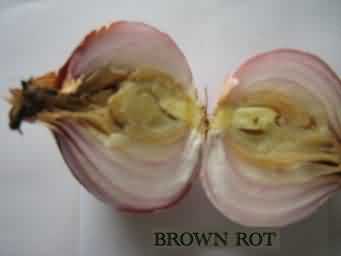 1. Brown rot in Onion and Garlic
1. Brown rot in Onion and Garlic
Pathogen: Pseudomonas aeruginosa
Symptoms:
Dark brown discoloration in bulb scale is the characteristics feature of this disease. Browning of inner scale along with rotting is the main symptoms of disease.
The rotting starts from the inner scale and spread to outer scales. Apparently, the bulb seems to be healthy, but when pressed, the white oozing is noticed from the neck.
In several cases the whole lot of bulbs gets rotten giving the bad odour in storage.
Management:
- Proper curing is required before storage.
- Use of maleic hydrazide and isopropyl phenyl carbamate (IPC) @ 20 ml/liter before one month of harvest.
- Neck cutting is about 2.5-3.0 cm.long above the bulb is reduced the bacterial infection.
- Light irrigation is required during entire cropping period.
2. Soft rot in Onin and Garlic
Pathogen: Erwinia caratovora
Symptoms:
Severe discolourations with soft rotting and water soaking of one or more of the inner fleshy scales of onion bulbs are the main symptoms of this disease. Severe infection occurs at high temperature.
The affected fleshy scale tissues are water soaked and pale yellow to light brown and become soft as the rot progresses. The whole bulb may break down and a watery liquid may ooze from the having foul odour as the disease advanced and, if squeezed.
The organisms generally appear just before or at the time of harvest or in storage. The pathogens are soil borne and may be spread in irrigation water.
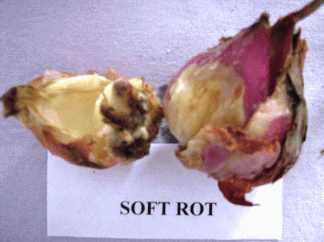
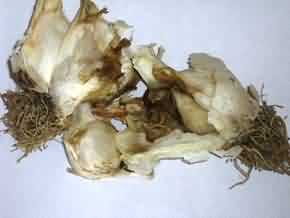
Management:
- Proper curing is required after harvest.
- Proper drainage is required during cropping period.
- Reduced the doses of nitrogenous fertilizers.
- Harvest only after onions tops are well matured.
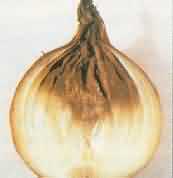 3. Neck rot in onion and garlic:
3. Neck rot in onion and garlic:
Pathogen: Botrytis allii (Pers.)
Symptoms:
Infection usually takes place through neck tissue and occasionally else where. The first sign is the softening of the effected tissue, which takes a sunken cooked appearance.
Later stage, decaying starts, which is separated from healthy tissue by a definite margin. A dense grayish mycelial mat after develops upon the decaying tissue of the scope bearing short conidiophores with conidia.
The disease progresses rapidly down the scales of neck tissue. Black sclerotial bodies are developed later. When diseased bulbs are cut open, water soaked brown tissues are seen near the neck region.
Management:
- Seed treatment with benomyl @1 gm/kg seed or benomyl + thiram @ 1 g/kg seed reduced the disease incidence.
- Pre harvest spray of benomyl @ 0.1% reduced the fungal infection.
- Proper curing is required before storage
- Neck cutting is 2.5-3.0 cm above the bulb to reduce the infection.
- Use planting stock free of the disease.
4. Iris Yellow Spot Virus (IYSV) in Onion and Garlic
Pathogen: Virus (Tospovirus)
Symptoms:
The disease symptoms vary among onion bulb and seed crops, but often appear as straw-colored, diamond shaped lesions on leaves and scapes with twisting or banding flower bearing stalks were observed in onion plants.
Some lesions have distinct green centre with yellow or tan borders, other lesions appears as concentric rings of alternating green and yellow/tan tissue. Infected plants can be scattered or generalized through out a field.
Large necrotic region may develop on scapes and cause a collapse of the escape. Diseased plants may be scattered or wide spread across a field, but the highest incidence of disease is often found on the field edges.
The virus infects most Allium species although garlic is not though to be a host. It also infects some ornamentals like, Iris, Lisianthus, Calendula and some weeds like, Jimson wed, chenopodium, tobacco redroot pigweed.
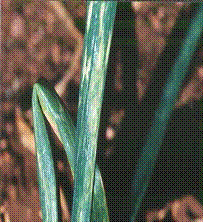
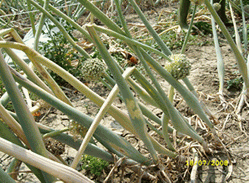
Management:
- Iris yellow spot virus(IYSV) is a top virus, similar to tomato spotted wilt virus, which is currently through to be vectored solely by onion thrips (Thrips tabaci), so alternate spray of softer insecticides formulations (spinosad, neem extract) and organic mulches(straw) is effective against IYSV.
- An integrated approach is essential for management of IYSV.
- Eliminate weeds in and around onion fields, especially volunteer onions and wild alliums.
5. Garlic Mosaic
Pathogen: Virus
Symptoms:
Garlic plants infected with mosaic virus show typical symptoms of chlorotic mottling and strips on the emerging leaf followed by pale yellow broken stripes resulting typical mosaic pattern on matured leaves.
Yellowish dots on leaves, whitish leaf margin, or twisting of leaves are also recorded on some cultivars. Generally symptoms are more pronounced in young leaves.
Management:
- Spraying of Monocrotophas @ 0.05%, Endosulphan @0.25% or methyl dematon @ 0.075% at 10-15 days intervals
- Cloves treatment with Bavistin @ 0.1% before planting
- Use of HNPV and some neem based botanicals at weekly intervals
6. Onion Yellow dwarf
Pathogen: Virus (Poty virus)
Symptoms:
Onion Yellow Dwarf Virus (OYDV) is an important pathogen of garlic and onion also, causing severe losses in garlic clones. It is an aphid-borne poty virus. It produces symptoms of mild chlorotic strips to bright yellow strips depending on virus isolate and cultivars.
Reduction in growth and bulb size also occurs. Infection by other viruses such as Leek yellow stripe, Garlic common latent virus and Shallot latent virus also occurs and may aggravate the symptoms further. However, OYDV is recognized as a major element of the virus disease complex.
Enzyme Linked Immunosorbant Assay (ELISA) is the main diagnostic method for large-scale routine detection of OYDV in garlic. The other method of OYDV detection is based on reverse transcriptase polymerase chain reaction (RT-PCR), which is 10-100 times more sensitive than ELISA.
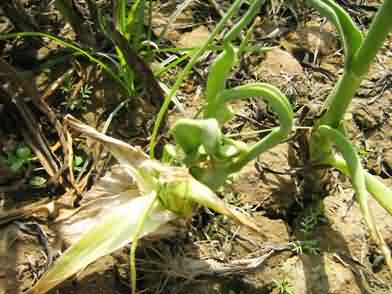
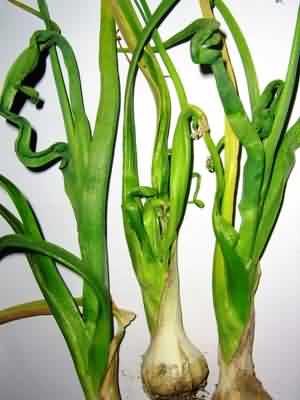
Management:
- Removal of virus infected plants.
- Alternate spray of systemic insecticides with neem based botanicals.
- Collect healthy seed from disease free plants.
Future Strategies
- A series of cultural and chemical control methods for onion and garlic diseases with targets varying with crop growth stage.
- Monitoring of new diseases and appropriate management strategies should be developed.
- Exploitation of disease resistance/tolerance observed in the screened improved lines.
- Large-scale use of fungal and bacterial bio-agents in a consortium to achieve better disease management.
- Studies on the use of Plant growth promoting Rhizobacteria (PGPR) in improving plant growth and offering protection from diseases.
- Develop techniques for quick diagnosis of viral diseases.
- Conversion of onion and garlic waste in to an antimicrobial agent.
- Develop IPM modules for onion and garlic diseases.
- Quarantine and legislation should be mandatory in these crops.
Authors:
R. K. Mishra1*, R. K.Gothwal2 and Rannpal Singh3
1The Energy and Resources Institute (TER), New Delhi-110003, INDIA
2S. K. Rajasthan Agricultural University, Bikaner-334006, Rajasthan, INDIA
3S.V.B.P. University of Agriculture and Technology, Meerut-250110, U. P., INDIA
*Corresponding Author:
